#abenaki tribe
Photo

Day 28 of creatuanary
Azeban, or mischievous raccon spirit from Abenaki people mythology. He decided to become a fire bender to cook the food he steals. Now he can make s’mores
#creatuanary#creatuanary 2023#azeban#raccoon#fire bender#fire bending#s’mores#Illustration#comic book artist#character design#abenaki#abenaki tribe#first nations#first nations lore#mythology#lore#folklore
39 notes
·
View notes
Text
i have been official recognised as an Abenaki citizen!! Yay!!!
#not telling you guys the band because that's personal#but im so excited!#i am finally officially a part of my tribe <3#abenaki#indigenous pride#indigenous
21 notes
·
View notes
Text
oh god, i have very little faith that “enemy in the fort” is going to be a good history mystery and that’s literally based on the outdated language it uses for native americans on the back cover
#THIS SEEMS LIKE ITS GONNA BE BAD#and it’s also involving the abenaki which i know more about than other tribes#literally this series is just ALLL over the place#also pretty sure this is the book where giving someone an allergic reaction is a plot point so. not good#wish me luck folks#ag#agblr#american girl doll#american girl#from my slate#american girl history mysteries
2 notes
·
View notes
Text

[image ID: digital illustration in the style of a TikTok still - a priest, “tommyholywater” according to the screen name watermark, is looking at the camera with the caption “I’m so h0rny. I can’t do this.” /end ID]
#I love this OC so much lmao#Tommy#he’s (fictional tribe based on the) Abenaki/Ojibwe#oc#artist on tumblr#digital illustration
5 notes
·
View notes
Text
Since ppl seem to keep spreading misinformation & using the wrong terms on here, here's a chart:
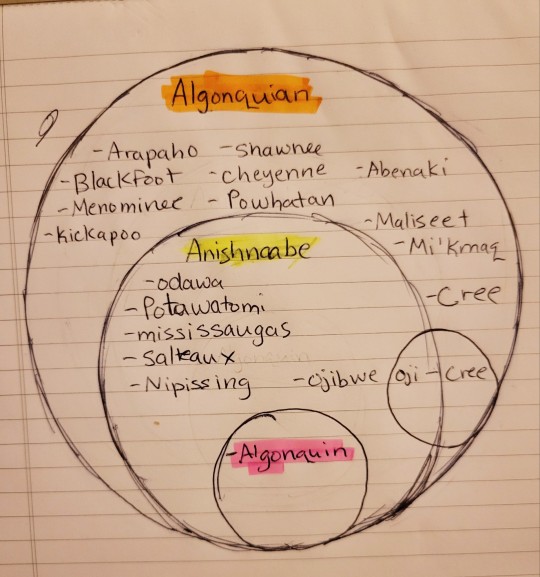
[Image description: photo of a venn diagram drawn on lined paper. There are 3 circles. The largest is labeled "Algonquian" & highlighted in orange marker, with the following languages written inside of it but not inside the other circles: "Arapaho, Blackfoot, Menominee, Kickapoo, Shawnee, Cheyenne, Powhatan, Abenaki, Maliseet, Mi'kmaq". The second, medium sized circle sits within the largest circle & is labeled "Anishnaabe" & highlighted in bright yellow, with the languages "Odawa, Potawatomi, Mississaugas, Salteaux, Nippising, & Ojibwe" written inside the second circle". The language "Oji-Cree" is labeled inside its own small circle intersecting with the Algonquian & Anishnaabe circle. Finally, the smallest circle is at the bottom & is inside the se one largest circle which is also inside the Algonquian circle. The smallest circle is labeled "Algonquin" & highlighted in pink. End description]
"Algonquian", ending with an "-uian", is a language family, with multiple languages & tribes that fall under it. The languages listed here is not exhaustive, & there are more Algonquian languages than listed here.
"Anishnaabe" is a group of culturally related tribes that lived near the Great Lakes region & were allied with each other, and all happen to fall under the Algonquian language family. Anishnaabe does not only exclusively refer to the Ojibwe tribe or language, though they often use this to refer to themselves. Not all Algonquian tribes fall under the "Anishnaabe" group, such as the Cree (except in the case of Oji-Crees), or Blackfoot.
"Algonquin", ending with just "-uin", is a singular tribe and language that is both in the Algonquian language family, as well as a part of the Anishnaabe language group.
2K notes
·
View notes
Text
It’s the Buck Moon Evan Buckley More Info:
*if I got any of this wrong please correct me and I’ll edit this post 🖤🖤
The Buck Moon is the seventh Full Moon of the 2024 calendar year and it was visible Saturday night (July 20) through early yesterday morning.
Multiple Native American tribes celebrate(d) this moon as a symbol of transformation and evolution. Depending on the area the tribe was/is located also reflects in the moons name:
The Cree (Canada and Montana in the present time) call it the Feather Moulting Moon
The Tlingit (Alaska) call it the Salmon Moon because it typically indicates that salmon have returned to the area and are ready to be harvested.
The Western Abenaki (tribes across Western Canada and Northern New England) call it the Thunder Moon because of the frequency of thunderstorms in and around July.
Other tribes use more plant and berry inspired names including but not limited to:
The Dakota (part of the Sioux nation and located in North & South Dakota, Minnesota, Nebraska and Montana) called it Moon When the Chokecherries are Ripe.
To the Anishinaabe (the Great Lakes area of the US and Canada) it’s the Berry Moon.
The Cherokee (today in modern day Oklahoma but originally in the Southeastern Woodlands {Tennessee, North Carolina, etc.} call it Month of the Ripe Corn Moon.
It’s the Raspberry Moon to the Algonquin & Ojibwe tribes. These tribes are located in Southern Quebec & eastern Ontario.
The Buck Moon is seen as a time for reflection, grounding & connecting with nature to promote a sense of balance and renewal. It encourages individuals to harness their inner strength, pursue new opportunities and to embrace change.
It spiritually symbolizes growth, strength and transformation.
The July Full Moon is called that as July is when a bucks (male deer) begin to grow new antlers for the coming mating season
@ohlookitsthearkhamknight @rdng1230 (I don’t remember if y’all asked for this or not) but here ya go! Thank you for indulging my research binge yesterday. This kind of long winded but I wanted to share with someone.
#Buck Moon Research#The one where the author spent too much of a Sunday researching The Buck Moon for a fic
6 notes
·
View notes
Quote
In his Changes in the Land (1983), William Cronon documented how Puritan ideas of Eden—an imaginary explicitly invoked by Monbiot’s title—distorted perceptions of the place the colonizers called New England. They perceived the Abenaki tribes as primitives in a paradise where deer abounded, forests provided good things to eat and soils were good for growing maize. Paradise fell apart when the settlers divided and fenced the land, not understanding that the indigenous peoples practised what would now be called agroforestry, attracting deer to specific places.
Harriet Friedmann, Farming Futures
93 notes
·
View notes
Text
Historical Fun Facts!
First, Happy Thanksgiving!
Most of us know about the legendary Squanto aka Tisquantum. Who belonged to the Patuxet tribe. He was kidnapped by English explorer Thomas Hunt who took him to Europe and trafficked him in Spain, where he sold him into slavery in the city of Málaga. He was ransomed by local monks who focused on their education and evangelization. When finally came back to America, he realized he was sole survivor of a disease epidemic (possibly from European settlers) that hit his tribe, who had lived at the site of Plymouth before the Pilgrims, from which he was the fist to interact with and taught the Plymouth settlers how to grow corn with fish. He also was able to convince the Wampanoag chief Massasoit to make an alliance with the Englishmen.
But a few things wrong here. Dispite what we see in movies and the Charlie Brown special. Squanto was Not the fist native to interact with the Pilgrims was it was an Abenaki named Samoset, who meet some Englishmen through their fishing expeditions and camps around the Gulf of Maine. Samoset, traveling through the area, noticed the Pilgrims’ settlement and approached to ask for beer. On his next visit Samoset brought Squanto, because Squanto had been to England and spoke much better English then him. And no Squanto didn't originally come up with the fertilizer using fish. It was never a Amerindian practice. He learned it from Europeans amongst whom he had lived. Whites in Europe and Newfoundland had long been using fish for fertilizing crops, including corn. Amerinds, who were primarily hunter-gatherers, relied on shifting cultivation sites. Squanto was important to the survival of the setters.
16 notes
·
View notes
Text
Ben & Jerry’s called on the U.S. to return “stolen indigenous land” to American Indians during its Independence Day message last week. Now a tribe in Vermont is asking the famous ice cream company to personally partake in that effort.
Don Stevens, chief of the Nulhegan Band of The Coosuk Abenaki Nation, told the New York Post on Friday that Ben & Jerry’s headquarters in South Burlington is located on Western Abenaki land.
If the company is “sincere,” Mr. Stevens told the newspaper, then he “looks forward to any kind of correspondence with the brand to see how they can better benefit Indigenous people.”
“If you look at the [Abenaki] traditional way of being, we are place-based people,” the chief told the Post. “Before recognized tribes in the state, we were the ones who were in this place.”
Mr. Stevens said that the Abenaki people view themselves as “stewards of the land.”
The state of Vermont recognizes four tribes that are descended from the Abenaki people, including the Nulhegan Abenaki Tribe. The Abenaki Alliance told Fox News Digital that their people had inhabited the land that included Vermont for 12,000 years.
Ben & Jerry’s July 4 message took aim specifically at Mount Rushmore in South Dakota, and called on the U.S. to return the land to the Lakota Sioux tribe.
Republican Gov. Kristi Noem came to the defense of her state’s most famous monument after the message went viral last week.
“We can learn from the men on that mountain, we can do better, but boy, they led us through some challenging times,” Mrs. Noem told Fox News on Thursday. “We should be proud of America and knock off what Ben & Jerry’s is doing.”
Bennett Cohen and Jerry Greenfield co-founded Ben & Jerry‘s in 1978. They sold the company in 2000, and as part of the agreement, the company has maintained its voice in social causes.
It has long supported Democrats and liberal causes.
47 notes
·
View notes
Text
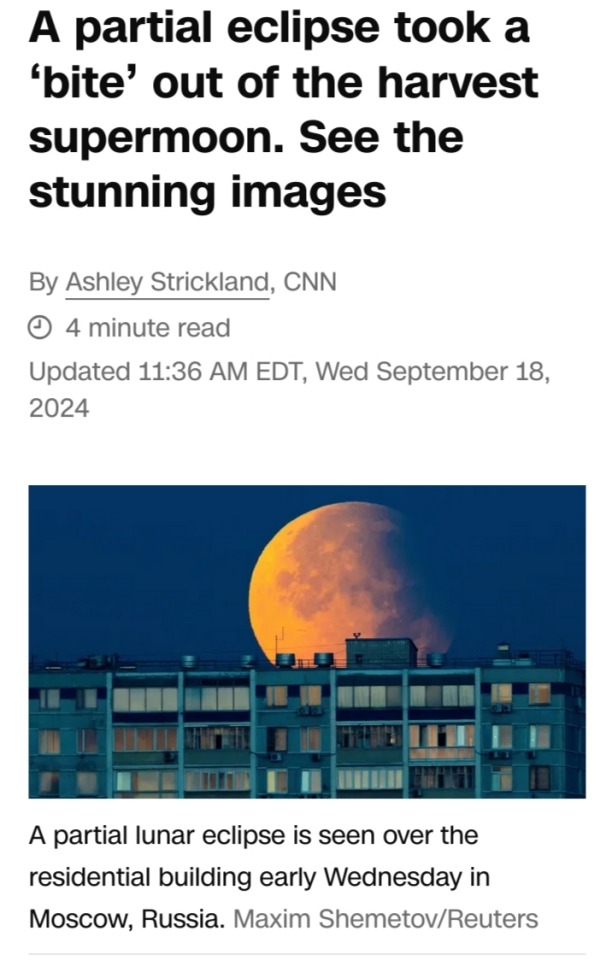
(CNN) — Sky-gazers around the world were able to glimpse a partial lunar eclipse while September’s full harvest moon shone brightly Tuesday night.
The moon peaked at its fullest at 10:35 p.m. ET Tuesday but will appear full through Thursday morning, according to NASA.
If you viewed the moon on Tuesday evening for about an hour, it also appeared as if a bite has been taken out of it due to a partial lunar eclipse.
A partial lunar eclipse occurs when Earth moves between the sun and the full moon without being perfectly aligned.
The celestial event appeared over Europe and much of Asia, Africa, North America, and South America.
The moon entered Earth’s full shadow at 10:13 p.m. ET and exited it at 11:16 p.m. ET.
The peak of the eclipse was expected to occur at 10:44 p.m. ET, according to NASA.
During a total lunar eclipse, Earth’s shadow can turn the moon’s surface a striking red color, which is known as a blood moon, according to NASA.
But that won’t be the case this week, experts say.

“The eclipse (Tuesday) will not be a total lunar eclipse, so the moon won’t appear red, instead a portion of the moon will darken,” said Noah Petro, NASA project scientist for both the Lunar Reconnaissance Orbiter and Artemis III.
“If you didn’t know it were happening or even look at the moon it might not be noticeable.
But the keen observer may notice the ‘top right’ corner of the moon darker than the rest of the moon,” he said via email.
“This is the part that is completely in(Earth’s) shadow, though not a large portion of the moon will be in darkness.
But if its clear out I encourage folks to go out and look, it’s always worthwhile to look at the moon!”

September’s full moon is also considered the second of four consecutive supermoons expected in 2024, according to NASA.
Definitions of a supermoon can vary, but the term generally denotes a full moon that is closer to Earth than normal and thus appears larger and brighter in the night sky.
Some astronomers say the phenomenon occurs when the moon is within 90% of perigee — its closest approach to Earth in orbit.
While the typical distance between Earth and the moon is an average of 238,900 miles (384,472 kilometers), September’s full moon was expected to be just 222,637 miles (358,300 kilometers) away, according to NASA.
And keep an eye out for Saturn, which will look like a bright dot close to the full moon.

Naming The Moon
The name harvest moon is a nod to the season because the event happens close to the beginning of fall, or the autumnal equinox, which occurs on September 22.
Many people associate the harvest moon with being orange in color as it begins to rise, but the same could be said of all full moons.
The hue is due to the greater thickness of Earth’s atmosphere near the horizon, according to EarthSky.
Typically, this time of year is when many summer-planted crops peak in the Northern Hemisphere, and the bright moon once helped farmers work into the evening to harvest their bounty ahead of the first frost, according to The Old Farmer’s Almanac.
Other monikers for September’s full moon — as used across various indigenous tribes — include the “moon of full harvest” from the Hopi people, the “corn maker moon” from the Abenaki tribe, the “moon of the brown leaves” from the Lakota people and “autumn moon” from the Passamaquoddy tribe.

European names for the moon also honor the fall harvest, including the “fruit moon,” a nod to the fruits that ripen as summer ends, and the “barley moon” to mark when the crop is collected from the fields, according to NASA.
Other harvest-celebrating traditions around this time include the Korean festival of Chuseok and the Chinese Mooncake Festival, both of which also celebrate family and the remembrance of ancestors.

Upcoming Celestial Events
The next full moon, the hunter’s moon occurring on October 17, will also be a supermoon and the closest of the year at 222,095 miles (357,428 kilometers) away.
The beaver moon will occur on November 15, and the final full moon of the year will be the cold moon on December 15.
Meanwhile, sky-gazers can anticipate a busy meteor shower season to close out 2024.
Here are peak dates for upcoming celestial activity, according to the American Meteor Society:
Draconids: October 7-8
Orionids: October 20-21
Southern Taurids: November 4-5
Northern Taurids: November 11-12
Leonids: November 17-18
Geminids: December 13-14
Ursids: December 21-22
#partial lunar eclipse#full harvest moon#earth#sun#full moon#moon#celestial event#NASA#total lunar eclipse#blood moon#Lunar Reconnaissance Orbiter#Artemis III#supermoon#perigee#harvest moon#autumnal equinox#fall#Northern Hemisphere#fruit moon#barley moon#Chuseok#Mooncake Festival#hunter’s moon#beaver moon
3 notes
·
View notes
Text
By: Aleks Phillips
Published: Jul 7, 2023
An Indigenous tribe descended from the Native American nation that originally controlled the land in Vermont the Ben & Jerry's headquarters is located on would be interested in taking it back, its chief has said, after the company publicly called for "stolen" lands to be returned.
Don Stevens, chief of the Nulhegan Band of The Coosuk Abenaki Nation—one of four descended from the Abenaki that are recognized in Vermont—told Newsweek it was "always interested in reclaiming the stewardship of our lands," but that the company had yet to approach them.
It comes after the ice cream company was questioned as to when it would give up its Burlington, Vermont, headquarters—which sits on a vast swathe of U.S. territory that was under the auspices of the Abenaki people before colonization.
"The U.S. was founded on stolen Indigenous land," the company said in a statement ahead of Independence Day. "This year, let's commit to returning it."
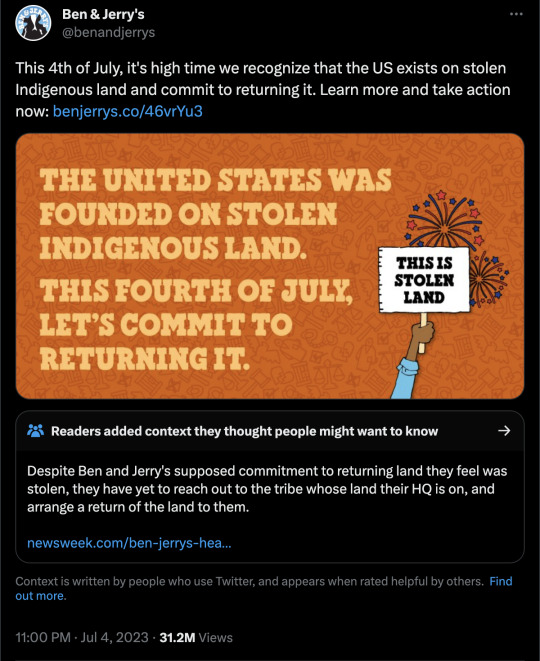
It added that the "land back" movement was about "ensuring that Indigenous people can again govern the land their communities called home for thousands of years," but focussed much of its statement on the taking of land from the Lakota in South Dakota.
The acknowledgment of historic tribal lands is a contentious subject, pitting the claims of Native Americans, whose ancestors were subject to violent persecution and displacement, against the status quo of a modern nation with entrenched borders.
While some say colonized ancestral lands should be at least partially returned, others say that it is impossible to decide which of the various groups to have claimed land throughout history it should be returned to.
Maps show that the Abenaki—a confederacy of several tribes who united against encroachment from a rival tribal confederacy—controlled an area that stretched from the northern border of Massachusetts in the south to New Brunswick, Canada, in the north, and from the St. Lawrence River in the west to the East Coast.
This would put Ben & Jerry's headquarters, located in a business park in southern Burlington, within the western portion of this historic territory—though it does not sit in any modern-day tribal lands.
"We are always interested in reclaiming the stewardship of our lands throughout our traditional territories and providing opportunities to uplift our communities," Stevens said when asked about whether the Nulhegan Abenaki Tribe would want to see the property handed over to Indigenous people.
While the chief said that the tribe "has not been approached in regards to any land back opportunities from Ben & Jerry's," he added: "If and when we are approached, many conversations and discussions will need to take place to determine the best path forward for all involved."
Ben & Jerry's has not yet publicly responded to calls to return the land its headquarters is situated on.
Newsweek contacted the company via email for comment on Friday.
A spokesperson for the Odanak Council of Abenakis, who now reside near Montreal, Canada, told Newsweek that the council would comment on the matter following their weekly meeting on Monday.
Newsweek also approached the Abenaki Nation of Missiquoi and the Elnu Abenaki Tribe—both recognized in Vermont—via email for comment on Thursday. Contact details for the other state-recognized tribe, the Koasek Traditional Band of the Koas Abenaki Nation, could not immediately be found.
According to historical records, the Abenaki initially traded with European settlers in the 16th century, but their population was afflicted by the spread of Old World diseases. The confederacy allied with French colonizers against English settlers in growing territorial disputes, before many fled to what is now Canada following a series of defeats at the hands of the English.
During the early part of the 20th century, a state-spon.sored eugenics program in Vermont saw some Abenaki sterilized. The Nulhegan Abenaki Tribe has described these acts as "ethnocide."
==
Checkmate.
They weren't stolen, they were conquered, as tribes have attacked, killed or driven out, and conquered each other's lands for thousands of years. Not just in North America, but worldwide. "Handing back" just gives it to the next most recent conquerors. Will they be racked by the inherited guilt of their own ancestors conquering the occupants who preceded them? Should they be? If not, why not?
Social media virtue signalling is cheap and easy. But walking the walk and talking the talk are two different things. High-priced CEOs, college presidents and other elites who espouse "antiracist" shibboleths such as "equity" rarely - although not never - act against their own self-interests by saying something like, "I'm a straight, white upper-middle class woman and I'm going to resign so that a disabled, fat, black, trans lesbian can take this position."
P.S. Community Notes are amazing.
#Aleks Phillips#Ben and Jerry's#Ben & Jerry's#virtue signal#virtue signaling#virtue signalling#land back#stolen land#woke#wokeness#cult of woke#wokeness as religion#wokeism#bluff called#community notes#community notes for the win#community noted#religion is a mental illness
23 notes
·
View notes
Text

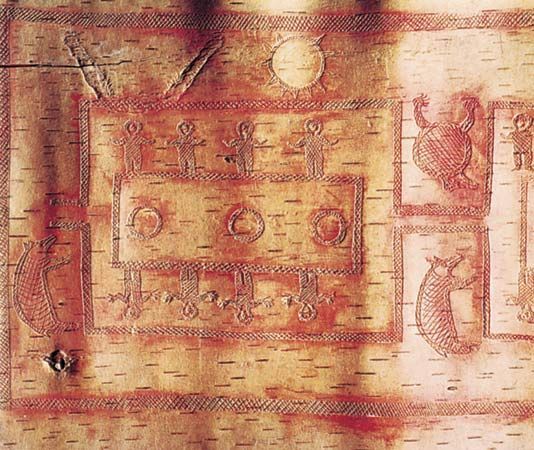

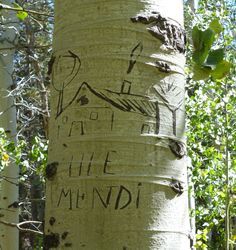
Top: Ojibwe and Abenaki birch bark scrolls. Used to hold ancestral stories and spirits, considered living beings themselves. Sometimes employed in Midewiwin, the Grand Medicine Lodge, a secretive teachings based religion amongst the New England native tribes.
Bottom: Basque Arboglyphs, a tradition among Basque-American sheepherders most commonly practiced between 1850's and 1930's. Found in Idaho, California, Oregon, and Nevada; these trees allow for Basque descendants to track the movement of their ancestors across the west in a time very little formal documentation of this group exist. Sheepherders once used these symbols to mark rest stops and shelter- and they could contain anything from poetry, local wildlife, images of prostitutes, or homages to Euskal Herria (which many had been forced to flee due to right wing violence).
97 notes
·
View notes
Text
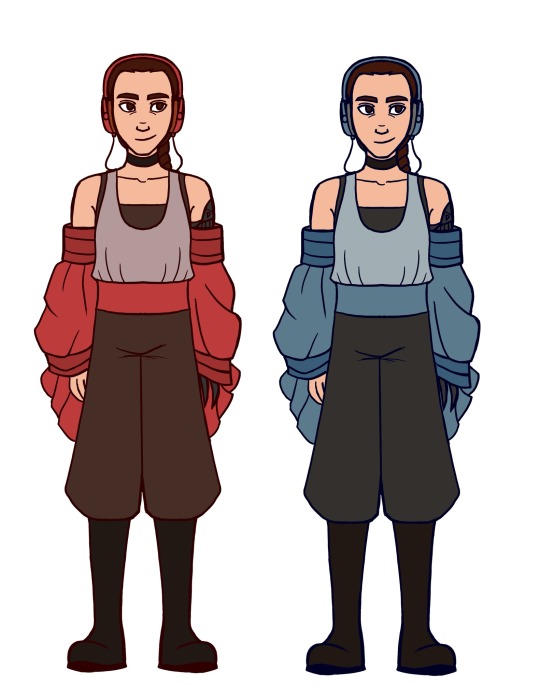
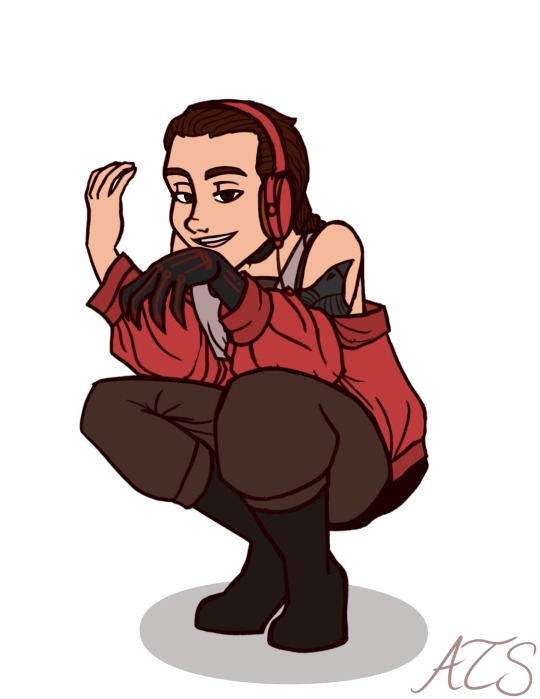
Ladies, gents, and all those in between and beyond, may I present...
The Hacker!
AKA Sage Corvid, age 28, and chronically tired hacker and computer virus programmer.
With their robotic arm, they are able to hack into any Dispenser, Teleporter, and Sentry in order to change the side of the device to service their own team for a brief time. They can also hack into Spy's disguise kit to disable it for a limited time as well. However, in both of these instances, they have to touch the device in question with the hand.
Alongside their Quick Hack arm, they also have a taser and a pistol. Their taser is built into their arm, so they have to be within melee distance to use it on someone to stun them. Their pistol is their long range device which doesn't do a lot of damage.
However, their final ability and arguably the most useful one is their shapeshifting ability: the ability to change into two animals (a crow and a cat.) They use this to sneak passed enemies and escape tricky situations more swiftly.
Small Things:
They have a tattoo of a crow on their left arm and a cat on their right arm.
The headphones they wear are noise-cancelling because they cannot stand the sound of bullets and loud noises in general.
Sage is Autistic and has BPD.
Under their oversized jacket, they have a machine strapped to their back that connects to their Quick Hack arm. It's basically the computer that is also connected to the headphones.
During fights, they always have music playing on their headphones.
They are seldom phased by shit.
They eventually develop a crush on Medic, who eventually returns their feelings
Backstory Stuff:
In 1940, Sage was born to a Yugoslavian father and American mother, who met right before the start of WWII. Their mother was forced to flee back to the United States because of the pregnancy, while their father remained in Yugoslavia to fight for the Partisans. Unfortunately, Sage's father arrived in the United States disabled post war.
Their mother and father were married when they were 5. For the next few years, Sage lived a happy childhood and learned Serbo-Croatian. However, at age 9, their parents were killed in a car accident, putting them in the care of their mother's tribe - the Abenaki. The US government tried to take them away multiple times, only for Sage to hide. It's here where Sage learned Western Abenaki.
It was among their people where they learned that they could shape-change into two animals (a crow and a cat), a gift that was passed down through Sage's father's side. Sage used this ability to escape out at night, play mischevious pranks, and escape unwanted situations. (This is often how they would escape the government looking for them.)
During these years, Sage lived with a war veteran who helped decode German messages. His name was Francis Brault, and he taught Sage all about codes and how to decode messages and other stuff. He even built his own computer. He taught Sage how to make one from spare parts, alongside how to fight and use guns. Francis also began working for IBM at this time, and this gave Sage a good window into computers and programming.
When Sage was 13, Francis took Sage to his work place, and Sage took to it very well - impressing Francis and some of his fellow programmers with their understanding of programs and computers. They were often invited by the programmers to experiment on their own, and their skills only seemed to improve (obviously they received help when they needed it.)
However, when Sage was 14, Francis died of cancer, and Sage was taken into the state's custody. Frustrated with being placed into foster care, Sage often avoided going back to their foster parent's "home" to go back to the IBM, where they were welcomed to come after school by the workers there who grew attached to the poor kid.
When they were 18, they aged out of the system, and Sage was effectively left alone. Their knowledge of computers and their fast growing skill with them allowed them to get a job working for a college in New York. And with this new job, they were the first person to create a computer virus.
During a regular day assisting with the computers, Sage found a rogue program in the system and used their own virus to combat it. They succeeded, but the person who actually messed up blamed them for the incident. Because of racism and general bigotry, Sage wasn't believed over the white guy and was fired.
At age 20, they began to built their own computers again, looting garbage bins and stole from hardware stores to do so. They moved to NYC, where they got a job as a cashier, but at night they'd make programs and computer viruses before sending them off via email to infect the systems of companies so they could steal money.
They did this for a while, worked for a few shady people as well, and started going by the name CROW. Learning from their mistakes, their programs and viruses became more and more advanced and dangerous. This eventually led them to discovering about Mann Co.
Originally it was just a curiosity, but as they began to syphon money from the company, they noticed that something wasn't right. This looked like a coverup for something else. Digging deeper, they found out about the Gravel War and found this to be especially interesting. They hacked the cameras to watch the fighting take place, finding it all very fascinating that these men were fighting over a gravel pit of all things.
However, they soon caught the attention of the Administrator due to a mistake on their part. And she sent someone after Sage. They kidnaped the enbie and took them to the Administrator, who offered them a deal. Either stay in Teufort and work for her, make tons of money, or be exposed as the thief who stole thousands from other companies and go to jail.
Sage chose the first option and became another mercenary. Their ultimate goal is to eventually take down the Administrator, but for the moment, seeing a bunch of grown men fight each other is equally fun.
#sage corvid#the hacker#tf2 hacker#tf2 oc#team fortress 2#tf2#team fortress 2 oc#my art#art#original character#self insert#tf2 self insert
32 notes
·
View notes
Text

One of my most recent paintings was originally named “Eskimo Sisters” until I was informed about the term “Eskimo” being derogatory. This was something I had no knowledge about prior so I thought I’d share my newfound knowledge with you all.
The claim that Eskimo is offensive is often supported by citing a popular etymology tracing its origin to an Abenaki word meaning “eaters of raw meat.” “Eskimo sisters" is a racist term that refers to any two women who have slept with the same man. It may have originated as a reference to Intuit pre-colonial plural marriages. The proper term for “Eskimo” is “Intuit” or “Aleut” depending on the tribe.
An alternative term for “Eskimo Sisters” is “Lumberjack Sisters”
The Kamasutra: Snake
By me
13 notes
·
View notes
Text


🌙𝐛𝐨𝐨𝐤 𝐫𝐞𝐯𝐢𝐞𝐰🌙
Sex, Lies and Sensibility by Nikki Payne
⭐️⭐️⭐️⭐️/5
Nora Dash’s life has just gone from bad to worse when she finds out that her father has just died and has a legit family, meaning her and her sister were the second “secret” family. Now on top of the unraveling family drama, Nora and her free spirited sister, Yanne, discover they inherited a dilapidated beach house in Maine that they have to fix up. So when Bear Freeman finds out spoiled, city girl Nora is planning on making changes on his Native land, he writes her off like every other greedy person he knows trying to capitalize on Indigenous people. Will Bear and Nora realize maybe working together might benefit them both…and when their friendship heats up will it be the sexual tension or their dark secrets that set them ablaze?
This was a great second novel by Nikki Payne! Set in the same world as Pride & Protest, SL&S was such a fun and funny book. Although, the original novel is not my favorite of Austen’s I really liked how Payne brought in basic plot points from the text but made it modern and new. Nora and Yanne were loveable characters, but honestly Bear is MY MAN!!!!!🫠🥵🤎 Why does Nikki Payne write Brown men so well? She truly did her research with the Abenaki tribe and culture, giving little details to make Bear, the reservation, and the story feel authentic. I also highly recommend the audiobook!!
**ngl I’ve been in a Jacob Black mood ever since this book! If anyone wants fanfiction recs for JB/wolf pack hit me up 🐺**
Read if you love:
🧡Friends to lovers
👒Sense and sensibility retelling
👥Dual POV
🌶️Spice
✊🏾Black/brown rep
#book aesthetic#book blog#aesthetic#bookworm#bookstagram#books#bookblr#book#book review#book reviewer#review#nikki payne#black bookstagram#black books#Abenaki#book edit#native american#sex lies and sensibility#sense and sensibility#jane austen#book rec#book recommendation#book recommendations
2 notes
·
View notes
Note
Why did the Cree has so much beef with other people
Depends on the time period dvehdtv.
Tribes we were allied with: Ojibwe & Salteaux (the besties <3), Blackfoot (its complicated), Algonquin, Assiniboin, Flathead Salish (we often got our horses from them), Haudenosaunee confederacy, Arapaho, Maliseet, Mandan, Abenaki
Tribes we were enemies with: Blackfoot confederacy, Inuit, Oceti Sakowin (namely the Dakota), Dene, Danezaa, Gros Ventres, Kootenay, & Shoshone, Mi'kmaq, Haudenosaunee confederacy (it's also complicated)
Like other peoples and wars in history, the allyship depended on the time period and circumstances. Some of the reasons why we might've been enemies was for scarcity of food, territory (but it's not in the same way Europeans would fight over land exactly, because our worldviews about land are different), interpersonal slights or interactions, access to horses, allying ourselves with certain tribes (like "an enemy of my friend is also my enemy" kind of thing, so we became enemies by association), and so on. At one point in history we might've been allies with a tribe & then later enemies with them. It really depends.
When the British met with Crees in the late 17th century, we were actually allies with the Blackfoot at the time, & we were warring together against the Shoshone. Later we were kind of off-and-on with the Blackfoot, but one of the reasons we were enemies later (especially in the 1800s), was because of the growing scareceness of food and encroaching on enemy territory to try get it. Blackfoot-Cree relations largely improved when Blackfoot Chief Crowfoot adopted Poundmaker (Cree) as his son, & he's the only reason Poundmaker's hair wasn't forcefully cut while he was in prison. Poundmaker also met with Sitting Bull at some point, and because Sitting Bull later became friends with Crowfoot, Lakota-Cree relations would've likely improved as well.
Some bands or subsections of Crees might not have been involved in certain conflicts as others due to culture and location or situation. Like, the Woodland Crees weren't so involved with the (Plains) Cree/Blackfoot wars or conflicts, even though they were allied with the Plains Crees & were our woodland cousins, because they weren't as nomadic. The conflicts with Inuit also pertained mostly to more Northern & Eastern suitated Crees, & the Innu. Innu being enemies with the Haudenosaunee at one point is I believe when the Plains Crees were actually allies with them (we liked getting wild rice & corn from them via the Ojibwe). & even when we were enemies, it was still pretty common to stop fighting and to invite even enemy tribes over so they could join in on ceremonies & religious events (& this wasn't exclusive to Crees, the Lakota also did this with the Pawnee)
There's also tribes that we sometimes ran into but didn't have necessarily bad or good relationships with, & we were just kind of neutral with each other, maybe sometimes traded. One example would be the Kiowa, who we ran into on occasion, but didn't interact with too much.
It's hard to summarize all here but yeah... it depends on the time period, place, tribe, band/subsections, and so on.
#to this day Blackfoot and Crees still roast each other rvsgrvtcs#anonymous#this has been a very basic introduction to Cree war history 101
107 notes
·
View notes